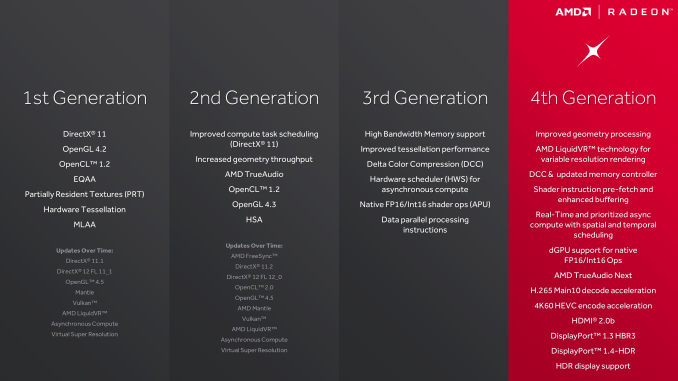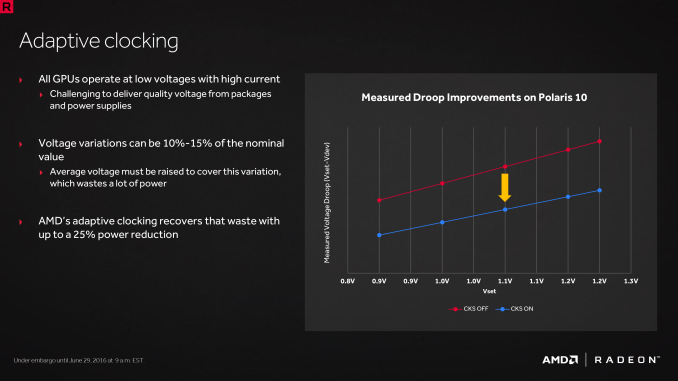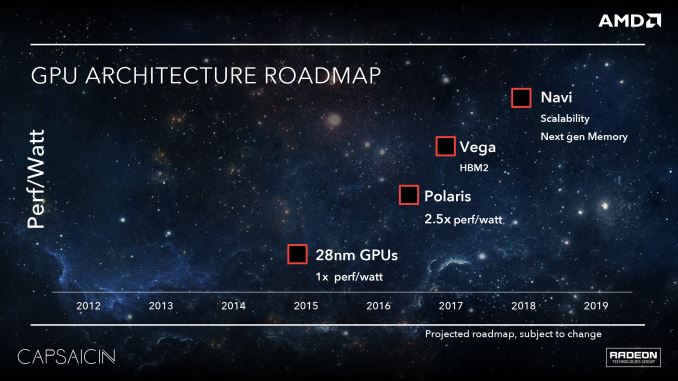The AMD Radeon RX 480 Preview: Polaris Makes Its Mainstream Mark
by Ryan Smith on June 29, 2016 9:00 AM ESTAMD's Path to Polaris
With the benefit of hindsight, I think in reflection that the 28nm generation started out better for AMD than it ended. The first Graphics Core Next card, Radeon HD 7970, had the advantage of launching more than a quarter before NVIDIA’s competing Kepler cards. And while AMD trailed in power efficiency from the start, at least for a time there they could compete for the top spot in the market with products such as the Radeon HD 7970 GHz Edition, before NVIDIA rolled out their largest Kepler GPUs.
However I think where things really went off of the rails for AMD was mid-cycle, in 2014, when NVIDIA unveiled the Maxwell architecture. Kepler was good, but Maxwell was great; NVIDIA further improved their architectural and energy efficiency (at times immensely so), and this put AMD on the back foot for the rest of the generation. AMD had performant parts from the bottom R7 360 right up to the top Fury X, but they were never in a position to catch Maxwell’s efficiency, a quality that proved to resonate with both reviewers and gamers.
The lessons of the 28nm generation were not lost on AMD. Graphics Core Next was a solid architecture and opened the door to AMD in a number of ways, but the Radeon brand does not exist in a vacuum, and it needs to compete with the more successful NVIDIA. At the same time AMD is nothing if not scrappy, and they can surprise us when we least expect it. But sometimes the only way to learn is the hard way, and for AMD I think the latter half of the 28nm generation was for the Radeon Technologies Group learning the hard way.
So what lessons did AMD learn for Polaris? First and foremost, power efficiency matters. It matters quite a lot in fact. Every vendor – be it AMD, Intel, or NVIDIA – will play up their strongest attributes. But power efficiency caught on with consumers, more so than any other “feature” in the 28nm generation. Though its importance in the desktop market is forum argument fodder to this day, power efficiency and overall performance are two sides of the same coin. There are practical limits for how much power can be dissipated in different card form factors, so the greater the efficiency, the greater the performance at a specific form factor. This aspect is even more important in the notebook space, where GPUs are at the mercy of limited cooling and there is a hard ceiling on heat dissipation.
As a result a significant amount of the work that has gone into Polaris has been into improving power efficiency. To be blunt, AMD has to be able to better compete with NVIDIA here, but AMD’s position is more nuanced than simply beating NVIDIA. AMD largely missed the boat on notebooks in the last generation, and they don’t want to repeat their mistakes. At the same time, starting now with an energy efficient architecture means that when they scale up and scale out with bigger and faster chips, they have a solid base to work from, and ultimately, more chances to achieve better performance.
The other lesson AMD learned for Polaris is that market share matters. This is not an end-user problem – AMD’s market share doesn’t change the performance or value of their cards – but we can’t talk about what led to Polaris without addressing it. AMD’s share of the consumer GPU market is about as low as it ever has been; this translates not only into weaker sales, but it undermines AMD’s position as a whole. Consumers are more likely to buy what’s safe, and OEMs aren’t much different, never mind the psychological aspects of the bandwagon effect.
Consequently, with Polaris AMD made the decision to start with the mainstream market and then work up from there, a significant departure from the traditional top-down GPU rollouts. This means developing chips like Polaris 10 and 11 first, targeting mainstream desktops and laptops, and letting the larger enthusiast class GPUs follow. The potential payoff for AMD here is that this is the opposite of what NVIDIA has done, and that means AMD gets to go after the high volume mainstream market first while NVIDIA builds down. Should everything go according to plan, then this gives AMD the opportunity to grow out their market share, and ultimately shore up their business.
As we dive into Polaris, its abilities, and its performance, it’s these two lessons we’ll see crop up time and time again, as these were some of the guiding lessons in Polaris’s design. AMD has taken the lessons of the 28nm generation to heart and have crafted a plan to move forward with the FinFET generation, charting a different, and hopefully more successful path.
Though with this talk of energy efficiency and mainstream GPUs, let’s be clear here: this isn’t AMD’s small die strategy reborn. AMD has already announced their Vega architecture, which will follow up on the work done by Polaris. Though not explicitly stated by AMD, it has been strongly hinted at that these are the higher performance chips that in past generations we’d see AMD launch with first, offering performance features such as HBM2. AMD will have to live with the fact that for the near future they have no shot at the performance crown – and the halo effect that comes with it – but with any luck, it will put AMD in a better position to strike at the high-end market once Vega’s time does come.













449 Comments
View All Comments
catavalon21 - Wednesday, July 13, 2016 - link
The review HardOCP did on the 480 in CF mode against the 1080 and 1070 suggests YOUR statement missed the mark...if only I could type, or proofread, or something.AbbieHoffman - Wednesday, June 29, 2016 - link
Well! I was going to buy the RX 480 to replace my GTX 970, But it looks like there is no point! I really thought the 480X was going to perform better than the 980.Meteor2 - Thursday, June 30, 2016 - link
If you want to replace your 970 you're going to have buy a 1070.Laststop311 - Thursday, June 30, 2016 - link
Hopefully this brings price of 1070 down to 299.99 for the custom ones.vladx - Thursday, June 30, 2016 - link
Good luck with thatamitp05 - Thursday, June 30, 2016 - link
AMD need to push performance UP by 15% and power consumption DOWN 15%. To make this card truly tempting and to match the hype they created.But I'll still buy AMD. We need them :(
AMD: Please don't Hype Zen too much. It feels bad when expectation you created are not met.
AntDX316 - Thursday, June 30, 2016 - link
If you want to support AMD just get XB2 and PS5.D. Lister - Thursday, June 30, 2016 - link
Nah, last time my GPU died, I spent several months on a crappy IGPU. AMD, or ANY company for that matter, didn't come for my support. Then why should I support any of them?GPU2016follower - Thursday, June 30, 2016 - link
I don't even know why I come here maybe just by curiosity but I don't trust anandtech and their biased reviews always in favor of Nvidia cards. In the majority of other websites' reviwers just to name few: Techspot, Forbes, Polygon, arstechnica, PCgamer, ... the RX 480 easily dominates the GTX 970 in 95 % gaming benchmarks by an average from 5 and up to 10fps and the RX 480 manages in very few cases to trail the GTX 980 by only 2 or 3 fps below.I think I will wait for the custom versions to see if they can offer better performance, maybe we will see the Sapphire, ASUS, XFX RX 480 beefed with their more powerful OC versions to compete against the GTX 980.
AntDX316 - Thursday, June 30, 2016 - link
The microstutter is way higher than nvidias offerings..Unfortunately certain things aren't made common like adaptive vsync/gsync, micro stutter, frame draw response time. FPS is what most of the gamers look for and soley chase. I believe because they are too busy thinking about what they were taught before and/or too busy with whatever else they are doing in life other than keeping up-to-date of what does matter for the best gaming experience and why. It took a while for people to move away from the you can only see 24/30 fps and no more.